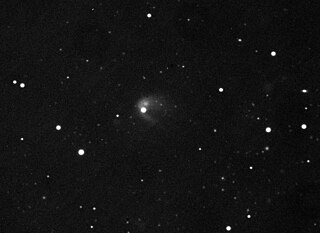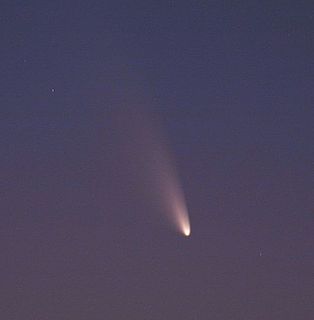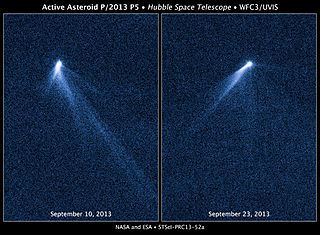Pan-STARRS is the Panoramic Survey Telescope and Rapid Response System in Hawaii, United States
Objects discovered by Pan-STARRS include
- Comets
- Interstellar asteroid
- ʻOumuamua (1I/2017 U1)
Pan-STARRS is the Panoramic Survey Telescope and Rapid Response System in Hawaii, United States
Objects discovered by Pan-STARRS include

The Panoramic Survey Telescope and Rapid Response System located at Haleakala Observatory, Hawaii, US, consists of astronomical cameras, telescopes and a computing facility that is surveying the sky for moving or variable objects on a continual basis, and also producing accurate astrometry and photometry of already-detected objects. In January 2019 the second Pan-STARRS data release was announced. At 1.6 petabytes, it is the largest volume of astronomical data ever released.

Active asteroids are small Solar System bodies that have asteroid-like orbits but show comet-like visual characteristics. That is, they show comae, tails, or other visual evidence of mass-loss, but their orbit remains within Jupiter's orbit. These bodies were originally designated main-belt comets (MBCs) in 2006 by astronomers David Jewitt and Henry Hsieh, but this name implies they are necessarily icy in composition like a comet and that they only exist within the main-belt, whereas the growing population of active asteroids shows that this is not always the case.
4150 Starr, provisional designation 1984 QC1, is a stony Florian asteroid from the inner regions of the asteroid belt, approximately 7 kilometers in diameter. It was discovered by American astronomer Brian Skiff at Lowell's Anderson Mesa Station on 31 August 1984. It was named after musician Ringo Starr.

C/2011 L4 (PanSTARRS), also known as Comet PANSTARRS, is a non-periodic comet discovered in June 2011 that became visible to the naked eye when it was near perihelion in March 2013. It was discovered using the Pan-STARRS telescope located near the summit of Haleakalā, on the island of Maui in Hawaii. Comet C/2011 L4 probably took millions of years to come from the Oort cloud. After leaving the planetary region of the Solar System, the post-perihelion orbital period is estimated to be roughly 107000 years. Dust and gas production suggests the comet nucleus is roughly 1 kilometer (0.62 mi) in diameter.

C/2012 K1 (PanSTARRS) is a retrograde Oort cloud comet discovered at magnitude 19.7, 8.7 AU from the Sun on 17 May 2012 using the Pan-STARRS telescope located near the summit of Haleakalā, on the island of Maui in Hawaii (U.S.).

311P/PanSTARRS also known as P/2013 P5 (PanSTARRS) is an asteroid discovered by Bryce T. Bolin using the Pan-STARRS telescope on 27 August 2013. Observations made by the Hubble Space Telescope revealed that it had six comet-like tails. The tails are suspected to be streams of material ejected by the asteroid as a result of a rubble pile asteroid spinning fast enough to remove material from it. This is similar to 331P/Gibbs, which was found to be a quickly-spinning rubble pile as well.
C/2014 G3 (PanSTARRS) is a faint comet discovered on 10 April 2014 by Pan-STARRS which will pass near Jupiter's gravitational field on 8 March 2016 at distance of 0.76 AU. The comet had about a 405-year orbital period before entering the planetary region of the Solar System. The comet will only brighten to around apparent magnitude 18 in 2015, and will require a large amateur telescope with a CCD camera to be detected. After this passage the comet will have a 391-year orbital period. C/2014 G3 has a spectra similar to S-type asteroids.
C/2012 S4 (PanSTARRS) is a non-periodic comet with the largest listed aphelion of any object on the JPL Small-Body Database. But the listed aphelion distance of 500,000 AU (8 ly) from the Sun is a generic near-perihelion unperturbed two-body solution that assumes the Sun and comet are the only two objects in the Universe. Other comets, such as C/2004 R4 (ASAS), C/2015 TQ209 (LINEAR) and C/2017 A3 (Elenin) have meaningless epoch-dependent solutions with aphelia of more than 1,000,000 AU (16 ly). As a comparison, the closest star, Proxima Centauri, is about 4.24 light years from the Sun, and Wolf 359 is 7.78 light years away. Any comet more than about 150,000 AU (2 ly) from the Sun can be considered lost to the interstellar medium. Using an epoch when C/2012 S4 (PanSTARRS) is beyond the planetary region of the Solar System, it is clear C/2012 S4 (PanSTARRS) will not be ejected from the Solar System.
C/2015 ER61 (PanSTARRS) is a comet, inner Oort cloud object. When classified as a minor planet, it had the fourth-largest aphelion of any known minor planet in the Solar System, after 2005 VX3, 2012 DR30, and 2013 BL76. It additionally had the most eccentric orbit of any known minor planet, with its distance from the Sun varying by about 99.9% during the course of its orbit, followed by 2005 VX3 with an eccentricity of 0.9973. On 30 January 2016, it was classified as a comet when it was 5.7 AU from the Sun. It comes close to Jupiter, and a close approach in the past threw it on the distant orbit it is on now.

Comet 252P/LINEAR is a periodic comet and near-Earth object discovered by the LINEAR survey on April 7, 2000. The comet is an Earth-Jupiter family comet, meaning that it passes quite close to both Earth and Jupiter. This causes its orbit to be perturbed frequently on an astronomical timescale.

(300163) 2006 VW139, provisional designations 2006 VW139 and P/2006 VW139, as well as periodic cometary number 288P, is a kilometer-sized asteroid from the outer regions of the asteroid belt and the first "binary main-belt comet" ever discovered.

C/2017 K2 (PanSTARRS) is an Oort cloud comet with a hyperbolic orbit, discovered in May 2017 at a distance beyond the orbit of Saturn when it was 16 AU (2.4 billion km) from the Sun. Precovery images from 2013 were located by July. It has been in the constellation of Draco since July 2007. As of January 2022, the 3-sigma uncertainty in the current distance of the comet from the Sun is ±1600 km. The comet is record breaking because it is already becoming active at such a distance. Only comet Hale–Bopp produced such a show from that distance with a similar nucleus. However, this comet will not be as visible as Hale–Bopp was in 1997, although it will reach naked eye visibility at perihelion. Astronomers had never seen an active inbound comet this far out, where sunlight is 1/225th its brightness as seen from Earth. Temperatures, correspondingly, are at -440 °F (-262 °C) in the Oort cloud. However, as it was approaching the Sun at a distance of 16 AU at discovery, a mix of ancient ices on the surface containing oxygen, nitrogen, carbon dioxide and carbon monoxide began to sublimate and shed as dust. This material expands into a vast 130,000 km (81,000 mi) wide halo of dust, called a coma, enveloping the solid nucleus.

C/2016 R2 (PanSTARRS) is a comet, discovered using the Pan-STARRS telescopes on September 7, 2016. The comet attracted attention from many astronomers as it approached its closest point to the sun in May 2018. It has been observed to have a very complex tail, which has been suggested to be due to a fast rotation period of the nucleus.

C/2017 U7 (PanSTARRS) is a hyperbolic comet, first observed on 29 October 2017 by astronomers of the Pan-STARRS facility at Haleakala Observatory, Hawaii, United States when the object was 7.8 AU (1.2 billion km) from the Sun. Despite being discovered only 10 days after interstellar asteroid 1I/'Oumuamua, it was not announced until March 2018 as its orbit is not strongly hyperbolic beyond most Oort Cloud comets. Based on the absolute magnitude of 10.6, it may measure tens of kilometers in diameter. As of August 2018, there is only 1 hyperbolic asteroid known, ʻOumuamua, but hundreds of hyperbolic comets are known.

C/2018 F4 (PanSTARRS) is a hyperbolic comet. It was discovered on 17 March 2018 when it was beyond the orbit of Jupiter, 6.4 AU (960 million km) from the Sun. It was quite far from the Sun and turned out to simply be an asteroidal object that was discovered before cometary activity was noticeable. As perihelion is inside the orbit of Jupiter, this object should become more active. In April 2018 it was determined to be a hyperbolic comet. Given that the incoming velocity was similar to that of an Oort cloud object, we can very confidently say that it is not of interstellar origin. C/2018 F4 fragmented around August 2020.
A Manx comet is a rocky, minor, celestial body that has a long-period comet orbit. Unlike most bodies on a long-period comet orbit which typically sport long, bright tails, the Manx comet is tailless, more typical of an inner Solar System asteroid. The nickname comes from the Manx breed of tailless cat. Examples include C/2013 P2 (PANSTARRS), discovered on 4 August 2013, which has an orbital period greater than 51 million years, and C/2014 S3 (PANSTARRS), discovered on 22 September 2014, which originates from the Oort cloud and could help explain the formation of the Solar System.
P/2016 G1 (PanSTARRS) was an asteroid that astronomers believe disintegrated in 2016.

C/2017 T2 (PanSTARRS) is an Oort cloud comet discovered on 2 October 2017 when it was 9.2 AU (1.38 billion km) from the Sun. The closest approach to Earth was on 28 December 2019 at a distance of 1.52 AU (227 million km). It came to perihelion on 4 May 2020 when it was safe from disintegration at 1.6 AU from the Sun.
C/2014 OG392 (PanSTARRS) is a comet discovered as a centaur on 28 July 2014 when it was 11.5 AU (1.72 billion km) from the Sun and had an apparent magnitude of 21. The comet was relatively easier to detect at this distance because the nucleus is estimated to be 20 km in diameter.
C/2021 O3 (PanSTARRS) is an Oort cloud comet, discovered on 26 July 2021 by the Pan-STARRS sky survey. It will come to perihelion on 21 April 2022 at 0.287 AU (42.9 million km). from the Sun. It might reach apparent magnitude 5 by late April 2022, but will only be 15 degrees from the Sun. C/2021 O3 will make its closest approach to Earth on 8 May 2022 at a distance of 0.60 AU (90 million km). As a dynamically new comet from the Oort cloud there is a high risk of disintegration.